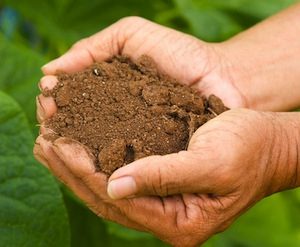Soil Health
By Dana Mulligan, VCE Horticulture Intern
 There is nothing as seemingly simple and common as dirt. It’s found in every city, every state, every continent. It goes unseen and unnoticed, except for when your kids have tracked it all over the house again. However, soil is one of the most precious resources the earth has to offer. It is the foundation upon which our world depends. It is not just a surface to walk on, but an essential provider of water filtration, biochemical cycles, habitat for countless organisms and many other ecosystem services. Most notably, it is the basis of all agriculture and thus the foundation for all of human civilization. As the world’s population skyrockets, it is more important than ever to take care of our soil so it can continue to meet the needs of 7.6 billion (possibly 10 billion by 2050) people.
There is nothing as seemingly simple and common as dirt. It’s found in every city, every state, every continent. It goes unseen and unnoticed, except for when your kids have tracked it all over the house again. However, soil is one of the most precious resources the earth has to offer. It is the foundation upon which our world depends. It is not just a surface to walk on, but an essential provider of water filtration, biochemical cycles, habitat for countless organisms and many other ecosystem services. Most notably, it is the basis of all agriculture and thus the foundation for all of human civilization. As the world’s population skyrockets, it is more important than ever to take care of our soil so it can continue to meet the needs of 7.6 billion (possibly 10 billion by 2050) people.
So, what makes for healthy soil? Soil health is defined as the “continued capacity of a soil to function as a vital living system within ecosystem and land-use boundaries, to sustain biological productivity, maintain the quality of air and water environments, and promote plant, animal and human health.” In short, healthy soil is productive, sustainable and profitable. It is soil that can support environmental health, animal health, plant health and human health.
 Soil is composed of four major components: air, water, mineral particles, and organic matter. Soil health indicators, which can be physical, chemical, or biological properties, provide an assessment of how well soil is functioning. Some examples of soil health indicators are the soil’s pH, nutrient holding capacity, porosity, compaction, microorganisms, and organic matter. An evaluation of several different soil health indicators is important for a full view of your soil’s health. If you would like to evaluate your soil’s health, there are a few home tests you can do. If you want a more comprehensive report on your soil’s health, you can get your soil tested by Virginia Tech.
Soil is composed of four major components: air, water, mineral particles, and organic matter. Soil health indicators, which can be physical, chemical, or biological properties, provide an assessment of how well soil is functioning. Some examples of soil health indicators are the soil’s pH, nutrient holding capacity, porosity, compaction, microorganisms, and organic matter. An evaluation of several different soil health indicators is important for a full view of your soil’s health. If you would like to evaluate your soil’s health, there are a few home tests you can do. If you want a more comprehensive report on your soil’s health, you can get your soil tested by Virginia Tech.
Whether you are a farmer, gardener, lawn enthusiast or anyone who wants to take better care of the land, there are many ways you can protect and improve your soil health. Below are a few suggestions to get you started.
For anyone:
Check your property for erosion. Covering bare soil with continuous plant cover makes a huge difference in reducing soil erosion. Planting trees, especially on hills and slopes, will help with this issue as well. Native plants are a great addition to prevent erosion and maintain soil health. Yard clippings can be composted and added back to your yard to improve the nutrient content of your soil.
For the lawn enthusiast:
If you’re passionate about maintaining a turfgrass lawn, practicing good soil health management will also improve your overall lawn health. Make sure to plant a grass species that is well suited for your hardiness zone and lawn conditions. For example, grasses that love sun won’t grow well in a shady lawn. Planting a mix of grass species will also benefit your soil and overall lawn health. Take care not to overapply nitrogen, as large doses can kill both plants and soil organisms. A better alternative is compost made of lawn clippings or other yard materials. You can also periodically aerate soil to reduce compaction.
For the gardener:
Mulching your garden will provide a protective layer over the soil, which helps to maintain soil moisture and temperature. Applying compost or manure will enrich the soil and provide more nutrients to your plants. Try to reduce pesticide use and use alternative methods of pest management, as pesticides can reduce populations of beneficial organisms. Be sure to rotate crops, as planting the same crop in the same place year after year will exhaust the soil.
For the farmers:
Excessive tillage breaks apart beneficial soil aggregates and reduces organic matter content over time, so reduce tillage if possible. Increase organic matter inputs by planting cover crops and adding manure and compost to your fields. Cover crops also help stabilize the soil and promote aggregation. Be sure to properly manage nutrients such as nitrogen and phosphorus, as overapplication can hurt both crops and the soil.
…edited 2024
References
-
References
- Living soil, healthy garden, University of Minnesota Extension
- Soil Health, Drainage, and Improving Soil, University of Maryland Extension
- What Makes Up a Healthy Soil?, Hans Klopp, South Dakota State University Extension
- Practical Tips for Healthy Soil in a Home Garden, Penn State Extension